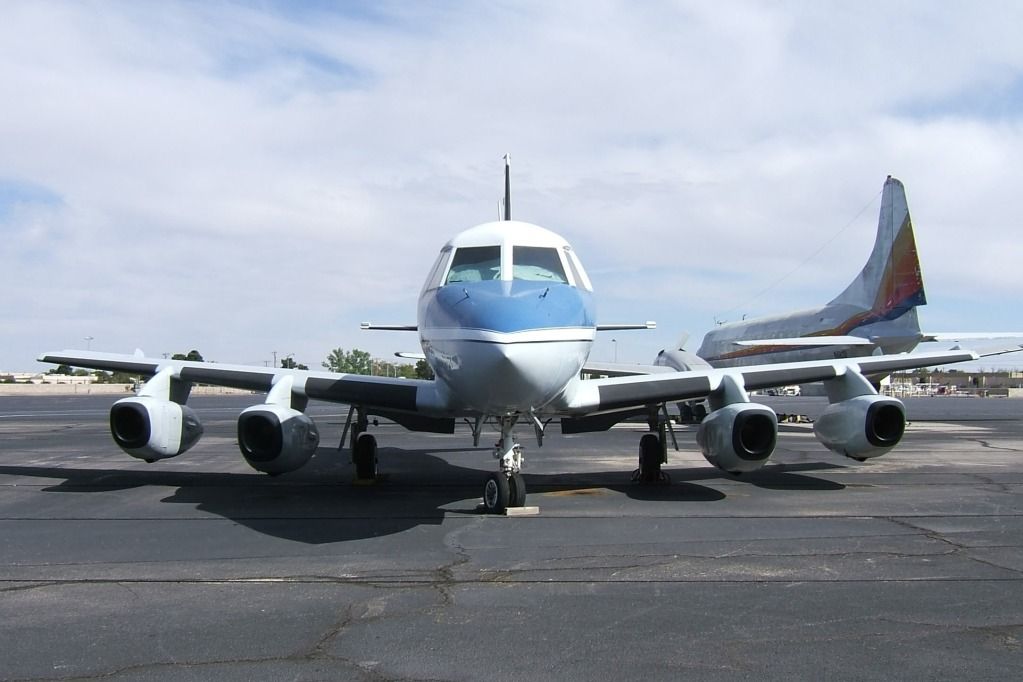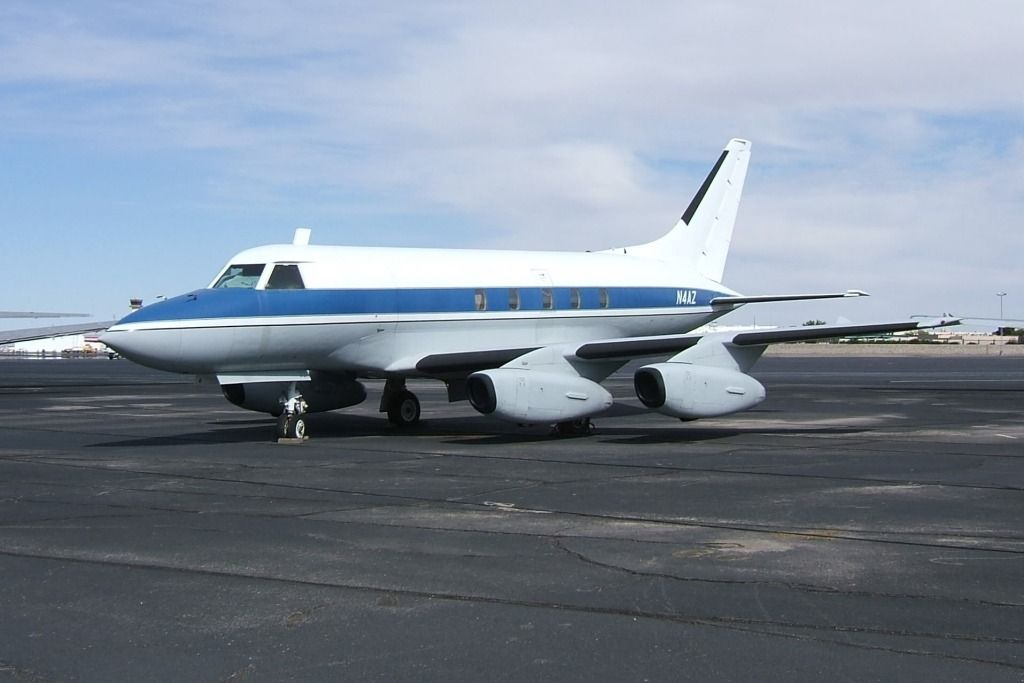

"A 1950's Ghost Comes To Life In Albuquerque"
The whine goes from the uncomfortable to the ear splitting. When it seems the din can't get any louder, it is joined by another to form a painful chorus of antique Westinghouse J-34 jet engines. Still another joins in and then yet another. Finally, the whine becomes more serious and the bare aluminum wings and airframe to which the engines are attached begins to move toward the active runway watched by a phalanx of restorers. After more than two decades of storage, the sole McDonnell 220 bizjet has come back to life and a new future.
Since being ferried to Albuquerque, N.M. in the early 1960s, the 220 has been a familiar inhabitant of the Great Southwest. A survivor of lawsuits, time, and fate, it was thought the airplane would never fly again. Now being restored under the eyes of a Washington farmer with ideas of putting the airplane to the use to which it was intended, the McDonnell 220 may yet find its place under the aeronautical sun.
The sole McDonnell 220, built in the mid 1950s as one of the first bizjets, has occupied its corner at the Albuquerque International Airport since the mid sixties. It was designed as a military transport but lost the intended Air Force contract to the Lockheed JetStar. Unable to find enough civilian buyers to justify the construction of a new manufacturing plant, McDonnell sold the airplane and a line of owners since were unable to get the huge hand-made airplane back into the air. Its current owner, who purchased the craft on a Friday the 13th in 1975, has only now been able to put together the financing needed to bring the airplane back to life. Preparations are under way to take the aircraft to the Hannover Air Show in West Germany where it is to make its debut. From that point the airplane will be again be at the mercy of marketing that dealt it such a cruel blow its first time around.
The aircraft is currently owned by Richard Archer, a wheat farmer from Washington state. Archer is one of four owners of the airplane since McDonnell released it. After the military's rejection of the airplane and an unsuccessful attempt at marketing it to business users, the airplane was sold as a tax write off to the Flight Safety Foundation for a token $1. The airplane was flown to Deer Valley Airport near Phoenix for crash testing.
FSF had just run an instrumented DC-7C into a dirt hill to test the crash worthiness of American civil aircraft. However, either because of the unique nature of the craft or someone's softheartedness, the airplane was never tested.
Instead, five years later it was sold to Allied Aircraft Sales in Tucson for $10,000 and then without so much as polishing the windshield, Allied turned around and sold it to Richard Durand of Westernair in Albuqurque for $1900. Durand eventually sold it to Archer.
Since sold by McDonnell the airplane has only flown once - from Deer Valley airport to Albuquerque Intercontinental Airport where it now sits. That flight was quite an experience, according to newspaper articles of the period. The first time fuel was pumped into the airplane's dehydrated wing, "More leaks than a shot gunned Lister Bag" appeared. Under the full weight of the 2,800 gallons, the nose gear collapsed with a sigh. A wingtip creamed by a gas truck years before was straightened out with a hammer and the long nose mounted pitot tube, bent over the years by airport kids had to be arm wrestled back into relative horizontal. When an engine was started, a small hole was burned in the asphalt beneath.
But the flight, although technically successful, caused some ire at McDonnell. Part of the company's contract with FSF stipulated the airplane would never be flown again. When McDonnell officials heard of Durand's flight, the aerospace giant apparently pressured FSF to sue Durand to keep the airplane forever on the ground. Newspaper stories state there was a "no-flight clause" in the sales contract turning the airplane over to Westernair.
A temporary restraining order was issued. Within a week, however, the order was reversed. The judge said it was up to normal FAA airworthy inspection procedures to determine the aircraft's flying merit.
Archer saw the airplane advertised in an aviation magazine one morning. He said by 9 p.m. that evening he was in Albuquerque and by the next morning, Friday the 13th, he had bought the airplane for $160,000. He said he bought the craft because he saw possibilities in marketing such a vehicle, something he wanted to try with some airplane even before he knew about the 220. "I had the frame and the airplane was the picture," he said.
Archer's father was an active private pilot who would let his three year old son handle the controls. Archer began flight training in 1948 at age 16. Though involved in many enterprises in Prescott, Wash., his primary vocation is that of a wheat farmer.
Archer said he wanted to restore the 220 to flying condition in 1975 but couldn't find enough funding to begin the project.
"Bankers hid behind their doors when I came in with this one," he said. Eventually, he sold part of his farm to finance the extensive restoration work.
With his son Tom, Archer contracted with Mark Wilson of Steward-Davis, Inc., a Long Beach, California aviation engineering company to oversee the restoration of the 220. Wilson makes his living working on special aviation projects. The 220 restoration team was put together at Altair in Albuquerque.
Work on the airplane began in October. The airplane was essentially dismantled with each system and part removed, inspected and overhauled if needed. It was a massive job. All four antique jet engines were overhauled and the 1950s-vintage electrical and hydraulic system inspected and repaired as needed. All bearings in the control systems were removed and replaced and the moving control surfaces were removed, inspected, balanced and put back onto the plane. The landing gear was swung 50 times in preparation for the first flight.
The work was done without reference to a single maintenance manual. The restoration group kept notes on the systems that can later be the basis for the manuals.
In early 1982, the remanufactured jet engines were started and taxi tests begun. Wilson said military and airline pilots passing by on Albuquerque's long runway were agape at the apparently shrunken DC-8 as it performed its first tests. Several problems delayed the first flight including a fuel leak. A recalcitrant nose wheel shimmy damper delayed the latest attempt. The nose wheel, apparently the same later used on the McDonnell F-101 fighter, was removed, overhauled and put back onto the airplane.
While the work was staggering, any idea of flying the airplane rested on the basic soundness of the airplane. Despite years of storage, the airplane's airframe, wings and major systems were still strong. Wilson said the airplane held up so well because it was designed by engineers who previously worked on nothing but military aircraft. The airplane's wing forgings, he said, rival that of the bigger Boeing 727 The basic airframe is rated to withstand 9 Gs of load, making the airplane capable of aerobatic flight. The pressurization system is also an example of the airplane's heft. While most bizjets have pressurization of about five psi, the 220's is rated for normal use up to 12 psi with an expected failure point of about 15 psi. Such a system could allow the airplane to fly higher than 70,000 ft.
The immediate plan for the 220 is to accumulate 10 hours flying over a desolate area of New Mexico for crew orientation and to run down maintenance squawks. After that, more hours are to be flown to convince the FAA that the 220 is capable of flying above 18,000 ft, into IFR conditions and terminal control areas. The aircraft will remain licensed under the experimental category as McDonnell abandoned the certification process shortly after losing the contract to Lockheed.
Archer's immediate goal is to take the airplane to the Hannover Airshow to "let people come to him for a change" with ideas about the airplane's potential use. At the very least Archer thinks the airplane can be an airshow success or someone's personal transport. Archer thinks the airplane can do more, however.
Because of its large size, sturdy construction, redundant systems and four engine capability, the 220 could be used as a test bed for new engine types - three conventional engines used for primary power. A lot of test equipment can be put into the airplane's large interior. Experimental avionics could also be tested in the airplane's wide performance envelope.
Also, there is a possibility of using the 220 as the basis a manufacturing program. Because the corporate world has caught up with the capability of the 220, the airplane may today have a market niche that wasn't there in 1956. Because the airplane is overly engineered, the fuselage could be lengthened for more seating. In conjunction with newer and more efficient engines including modern turboprops, the airplane could someday be the basis of a new air carrier airplane.
Wilson said that surprisingly few changes would have to be made to bring the airplane up to modern standards. McDonnell pioneered many new systems that are now state-of-the-art. One major change that would have to be made would be replacing the 1950s-vintage single-cylinder hydraulic system with a modern two-cylinder type. The single-tire main landing gear would have to be replaced with modern low-pressure dual units.
Modern avionics would be needed as would some type of new technology engines. Changing the airplane's large air conditioning and pressurization unit located behind the aft cabin wall with a more modern unit would free enough space to install several new seats. The old-fashioned inward-opening main door would need to be replaced with a modern outward-opening unit.

